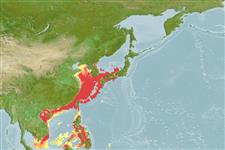Common names from other countries
Environment: milieu / climate zone / depth range / distribution range
Ecologia
Oceanódromo (Ref. 75927); intervalo de profundidade 10 - 150 m (Ref. 275), usually 60 - 150 m (Ref. 75927). Subtropical; 15°C - 25°C (Ref. 75927); 41°N - 6°N, 104°E - 138°E (Ref. 1695)
Western Pacific: South and East China seas, Japan to Philippines and Indonesia.
Length at first maturity / Tamanho / Peso / Idade
Maturity: Lm ? range ? - ? cm Max length : 18.0 cm ML macho/indeterminado; (Ref. 275); Peso máx. publicado: 600.00 g (Ref. 1695)
Caught by otter trawls, pound nets, hoop nets and hook-and-line (Ref. 346). Sometimes found burrowing in the substrate (Ref. 275).
Life cycle and mating behavior
Maturidade | Reprodução | Desova | Ovos | Fecundidade | Larvas
Members of the class Cephalopoda are gonochoric. Male and female adults usually die shortly after spawning and brooding, respectively. Mating behavior: Males perform various displays to attract potential females for copulation. During copulation, male grasp the female and inserts the hectocotylus into the female's mantle cavity where fertilization usually occurs. Life cycle: Embryos hatch into planktonic stage and live for some time before they grow larger and take up a benthic existence as adults.
Roper, C.F.E., M.J. Sweeney and C.E. Nauen. 1984. (Ref. 275)
Categoria na Lista Vermelha da IUCN (Ref. 130435)
Categoria CITES (Ref. 108899)
Not Evaluated
Not Evaluated
Utilização humana
Pescarias: espécies comerciais
| FishSource |
Ferramentas
Fontes da internet
Estimates based on models
Preferred temperature
(Ref.
115969): 11.6 - 23.2, mean 18.5 (based on 195 cells).
Prior r = 0.31, 95% CL = 0.20 - 0.47, Based on 1 full stock assessment.
Vulnerabilidade
Low vulnerability (10 of 100).
